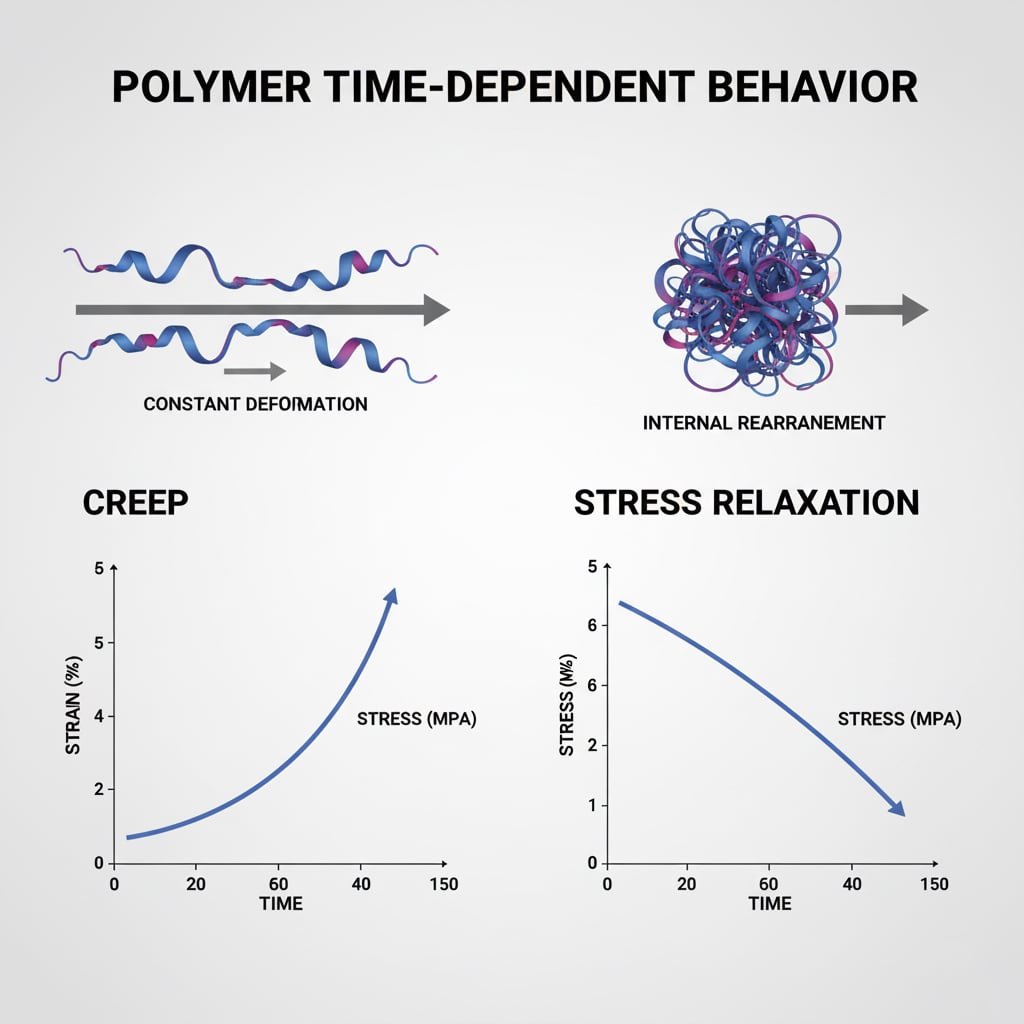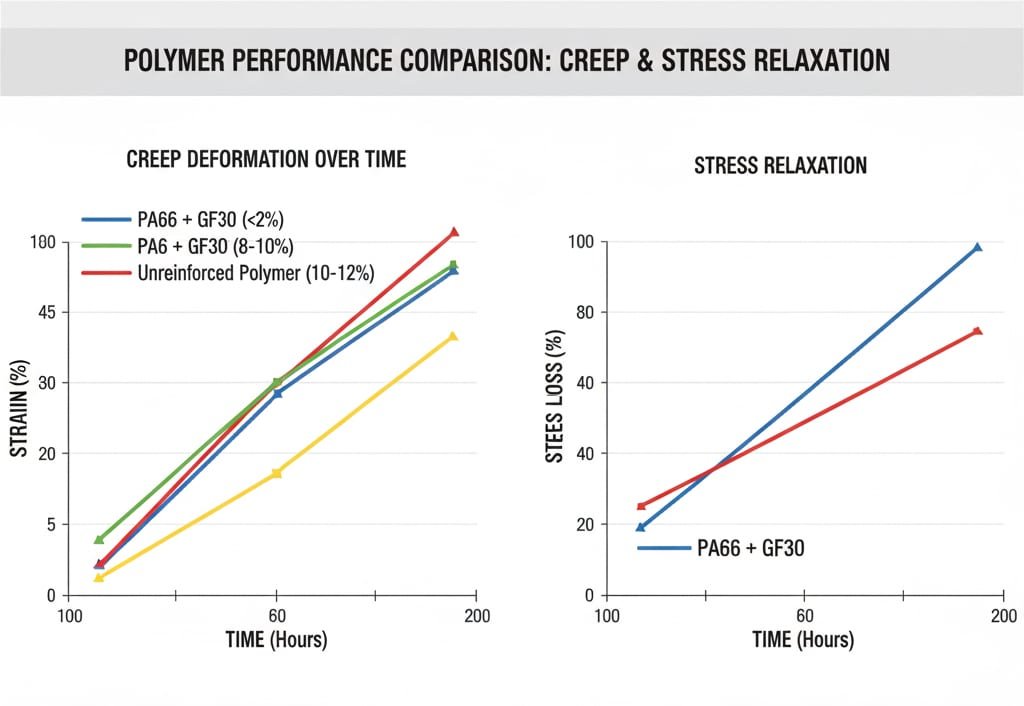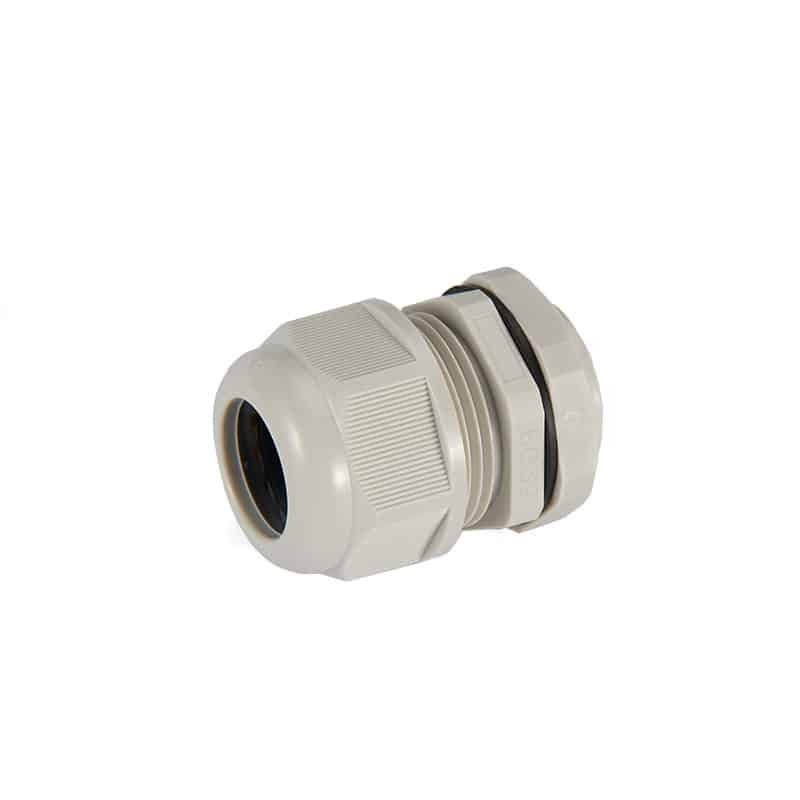Introduction
Polymer cable glands that perform perfectly during initial installation can gradually lose their sealing effectiveness over months or years, leading to moisture ingress, IP rating1 failures, and costly equipment damage. This silent degradation often goes unnoticed until catastrophic failure occurs, making understanding long-term material behavior critical for reliable installations.
Creep causes permanent deformation under constant load while stress relaxation reduces sealing force over time, with high-quality nylon PA66 cable glands showing creep rates below 2% after 1000 hours and stress relaxation under 15% after one year, making them suitable for long-term applications when properly selected and installed.
After a decade of working with clients who’ve experienced unexpected polymer cable gland failures, I’ve learned that understanding creep and stress relaxation isn’t just about material science—it’s about preventing the gradual failures that can compromise entire electrical systems without warning.
Table of Contents
- What Are Creep and Stress Relaxation in Polymer Cable Glands?
- How Do Temperature and Load Affect Long-Term Performance?
- Which Polymer Materials Offer the Best Long-Term Stability?
- How Can You Predict and Prevent Long-Term Failures?
- What Testing Methods Evaluate Long-Term Performance?
- FAQs About Polymer Cable Gland Long-Term Performance
What Are Creep and Stress Relaxation in Polymer Cable Glands?
Understanding these time-dependent material behaviors is essential for predicting long-term cable gland performance.
Creep is the gradual deformation of polymer cable glands under constant stress over time, while stress relaxation is the gradual reduction of internal stress under constant deformation, both phenomena directly affecting sealing force and IP rating maintenance in long-term installations.

The Science Behind Time-Dependent Behavior
These phenomena occur at the molecular level in polymer materials:
Creep Mechanism:
- Polymer chains gradually slide past each other under load
- Molecular entanglements slowly disentangle over time
- Temperature accelerates molecular motion and creep rate
- Results in permanent dimensional changes
Stress Relaxation Mechanism:
- Internal stresses redistribute within the polymer matrix
- Molecular chains rearrange to lower energy states
- Reduces the force exerted by compressed sealing elements
- Leads to gradual loss of sealing pressure
At Bepto, we conduct extensive long-term testing to characterize these behaviors in our nylon cable glands, ensuring predictable performance over their intended service life.
Impact on Cable Gland Performance
Creep Effects:
- Thread engagement loosening over time
- Gasket compression loss leading to seal failure
- Dimensional changes affecting cable grip
- Potential IP rating degradation
Stress Relaxation Effects:
- Reduced clamping force on cables
- Decreased sealing pressure at gasket interfaces
- Gradual loss of strain relief effectiveness
- Increased susceptibility to vibration loosening
Understanding these mechanisms helps predict when maintenance or replacement may be necessary.
How Do Temperature and Load Affect Long-Term Performance?
Environmental conditions dramatically influence the rate and extent of creep and stress relaxation in polymer cable glands.
Temperature increases creep rates exponentially following Arrhenius behavior2, with every 10°C rise potentially doubling deformation rates, while higher mechanical loads accelerate both creep and stress relaxation, making environmental assessment critical for service life prediction.
Temperature Dependency Analysis
I worked with Marcus, a facilities manager at a solar farm in Arizona, USA, where ambient temperatures regularly exceed 50°C. His original nylon cable glands were experiencing premature failures after just 18 months, with visible deformation and compromised sealing.
Temperature Effects on Polymer Behavior:
| Temperature Range | Creep Rate Multiplier | Stress Relaxation Rate | Recommended Action |
|---|---|---|---|
| -20°C to +20°C | 1.0x (baseline) | Normal | Standard materials |
| +20°C to +40°C | 2-3x | Accelerated | Monitor closely |
| +40°C to +60°C | 5-8x | Rapid | Heat-stabilized grades |
| +60°C to +80°C | 10-15x | Very rapid | Specialized compounds |
Load Dependency Factors:
- Installation torque levels
- Cable pulling forces
- Thermal expansion stresses
- Vibration and cycling loads
Marcus’s solar installation required heat-stabilized nylon compounds with enhanced creep resistance. Our upgraded cable glands have now been performing reliably for over three years in the harsh desert environment.
Accelerated Aging Predictions
Arrhenius Modeling:
- Predicts long-term behavior from short-term high-temperature tests
- Typical acceleration factors: 10°C increase = 2x rate
- Enables 20-year predictions from 1000-hour tests
- Critical for warranty and maintenance planning
Time-Temperature Superposition3:
- Combines temperature and time effects
- Creates master curves for performance prediction
- Accounts for material transitions and failure modes
- Validates accelerated test protocols
Which Polymer Materials Offer the Best Long-Term Stability?
Material selection dramatically impacts long-term performance in demanding applications.
Nylon PA664 with glass fiber reinforcement demonstrates superior long-term stability with creep rates below 2% after 1000 hours at rated temperature, compared to standard PA6 at 3-5% and unreinforced polymers at 8-12%, making it the preferred choice for critical long-term installations.

Material Performance Comparison
High-Performance Polymers:
| Material | Creep Resistance | Stress Relaxation | Temperature Limit | Cost Factor |
|---|---|---|---|---|
| PA66 + GF30 | Excellent | Good | 120°C | 1.5x |
| PA6 + GF30 | Good | Fair | 100°C | 1.2x |
| PA66 Standard | Fair | Fair | 80°C | 1.0x |
| PA6 Standard | Poor | Poor | 70°C | 0.9x |
| POM | Good | Excellent | 90°C | 1.3x |
Glass Fiber Reinforcement Benefits:
- Reduces creep rates by 60-80%
- Improves dimensional stability
- Maintains stiffness at elevated temperatures
- Enhances long-term load-bearing capability
Advanced Polymer Formulations
I remember working with Fatima, who manages a petrochemical facility in Jubail, Saudi Arabia. Her application required cable glands that could maintain sealing integrity for 10+ years in a high-temperature, chemically aggressive environment.
Specialized Additives:
- Heat stabilizers prevent thermal degradation
- UV stabilizers for outdoor applications
- Nucleating agents improve crystallinity
- Impact modifiers maintain toughness
Molecular Weight Considerations:
- Higher molecular weight reduces creep
- Improved entanglement density
- Better stress distribution
- Enhanced long-term performance
Fatima’s facility chose our premium PA66 cable glands with specialized heat stabilization. After five years of operation, testing shows minimal degradation and continued excellent sealing performance.
Quality Indicators for Long-Term Performance
Material Certification Requirements:
- Melt flow index consistency
- Molecular weight distribution
- Additive package verification
- Thermal stability testing
Processing Quality Factors:
- Proper drying before molding
- Controlled cooling rates
- Stress relief annealing
- Dimensional accuracy verification
How Can You Predict and Prevent Long-Term Failures?
Proactive approaches can identify potential issues before they cause system failures.
Long-term failure prediction combines accelerated testing data, environmental monitoring, and periodic inspection protocols, enabling maintenance scheduling and replacement planning before sealing integrity is compromised, typically recommending inspection intervals of 2-5 years depending on operating conditions.
Predictive Maintenance Strategies
Environmental Monitoring:
- Temperature logging for thermal history
- Load monitoring for stress assessment
- Chemical exposure documentation
- UV radiation measurement for outdoor installations
Inspection Protocols:
- Visual examination for deformation signs
- Torque verification for thread engagement
- IP rating testing for seal integrity
- Dimensional measurement for creep assessment
Failure Mode Analysis:
- Identify primary degradation mechanisms
- Establish critical performance thresholds
- Develop inspection criteria and intervals
- Create replacement decision matrices
Prevention Strategies
Design Optimization:
- Minimize stress concentrations
- Provide adequate safety factors
- Account for environmental extremes
- Include thermal expansion allowances
Installation Best Practices:
- Follow specified torque values
- Ensure proper thread engagement
- Verify gasket positioning
- Document installation parameters
Material Selection Guidelines:
- Match material properties to application
- Consider worst-case environmental conditions
- Evaluate total cost of ownership
- Specify appropriate safety factors
At Bepto, we provide comprehensive application guides and maintenance recommendations to help maximize the service life of our polymer cable glands.
What Testing Methods Evaluate Long-Term Performance?
Standardized testing protocols provide reliable data for long-term performance prediction.
ASTM D29905 creep testing and ASTM D6112 stress relaxation testing provide quantitative data for polymer cable gland long-term performance, with typical test durations of 1000-10000 hours at elevated temperatures to accelerate aging and enable service life predictions of 20+ years.
Standard Test Methods
Creep Testing (ASTM D2990):
- Constant load application over time
- Deformation measurement at intervals
- Temperature-controlled environment
- Multiple stress levels for characterization
Stress Relaxation Testing (ASTM D6112):
- Constant deformation maintenance
- Force measurement over time
- Identifies sealing force retention
- Critical for gasket applications
Accelerated Aging (ASTM D5510):
- Elevated temperature exposure
- Mechanical property retention
- Arrhenius extrapolation
- Long-term prediction validation
Test Protocol Development
Sample Preparation:
- Representative geometry and size
- Proper conditioning procedures
- Multiple specimens for statistics
- Control samples for comparison
Environmental Conditions:
- Temperature selection based on service
- Humidity control when relevant
- Chemical exposure simulation
- Load application methods
Data Analysis:
- Statistical evaluation of results
- Confidence interval calculation
- Failure mode identification
- Service life prediction models
Quality Assurance Applications
Incoming Material Verification:
- Batch-to-batch consistency
- Specification compliance
- Accelerated screening tests
- Supplier qualification
Process Control Monitoring:
- Production parameter tracking
- Property trend analysis
- Early warning systems
- Corrective action protocols
Our testing laboratory at Bepto maintains comprehensive databases of long-term performance data, enabling accurate service life predictions and continuous product improvement.
Conclusion
Understanding creep and stress relaxation is crucial for selecting polymer cable glands that will maintain their sealing integrity over extended service periods. While these time-dependent behaviors are inevitable in all polymers, proper material selection, environmental assessment, and predictive maintenance can ensure reliable long-term performance. High-quality nylon PA66 with glass fiber reinforcement offers the best balance of creep resistance and cost-effectiveness for most applications. The key is matching material properties to your specific operating conditions and implementing appropriate monitoring protocols. At Bepto, we combine extensive testing data with practical application experience to help you select polymer cable glands that will perform reliably throughout their intended service life. Remember, investing in proper long-term performance analysis today prevents unexpected failures tomorrow! 😉
FAQs About Polymer Cable Gland Long-Term Performance
Q: How long do nylon cable glands typically last in outdoor applications?
A: High-quality nylon PA66 cable glands typically last 15-20 years in standard outdoor conditions, with UV-stabilized grades extending this to 25+ years. Service life depends on temperature extremes, UV exposure, and mechanical loading conditions.
Q: What are the early warning signs of creep failure in cable glands?
A: Look for visible deformation of threaded components, loosening of installation torque, gaps at sealing interfaces, and reduced cable grip force. Regular torque checks can identify problems before complete seal failure occurs.
Q: Can stress relaxation be reversed or prevented in polymer cable glands?
A: Stress relaxation cannot be reversed but can be minimized through proper material selection, controlled installation torque, and avoiding over-compression. Heat-stabilized compounds and glass fiber reinforcement significantly reduce relaxation rates.
Q: How do you accelerate testing to predict 20-year performance?
A: Accelerated testing uses elevated temperatures following Arrhenius principles, typically testing at 80-120°C for 1000-10000 hours to predict room temperature performance over decades. Time-temperature superposition validates these extrapolations.
Q: Should I replace polymer cable glands preventively or wait for failure?
A: Preventive replacement is recommended for critical applications based on predictive maintenance schedules, typically every 10-15 years for standard conditions or 5-8 years for severe environments. The cost of replacement is minimal compared to failure consequences.
-
See a detailed chart explaining the different Ingress Protection (IP) ratings for dust and moisture resistance. ↩
-
Learn about the Arrhenius equation and how it’s used to model the relationship between temperature and the rate of chemical reactions, like polymer degradation. ↩
-
Explore the Time-Temperature Superposition (TTS) principle, a key concept in polymer science for predicting long-term mechanical behavior. ↩
-
Review the technical properties, advantages, and common industrial applications of Polyamide 66 (PA66). ↩
-
Read the official summary and scope of the ASTM D2990 standard for determining the creep properties of plastics under constant load. ↩



